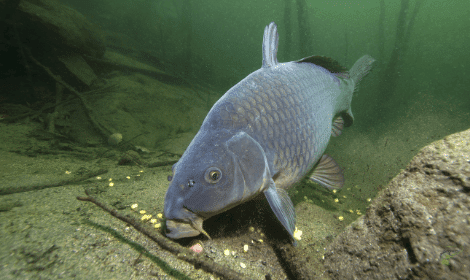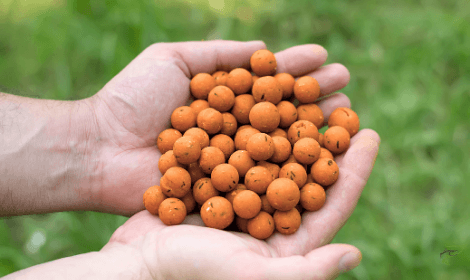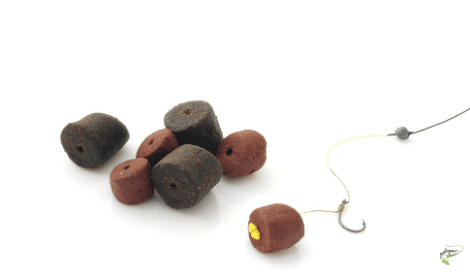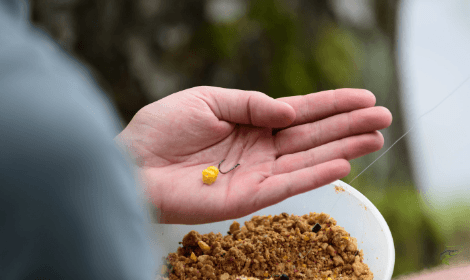
Carp have a very diverse diet and get sustenance from a very wide range of foods. Let’s take a closer look at what carp eat in the wild, as well as some popular bait types that anglers use
Carp are Specialized Feeding Machines
Before we get into what carp eat it’s important to understand just how carp feed once they have found a meal.
Carp have teeth inside of their throat. These teeth are called pharyngeal teeth and look similar to molars and help crush food such as snails, seeds, and plant matter.
Along with the aid given by these teeth in eating a wide array of food, carp also have two appendages that protrude from their mouth area called barbules.
These barbules are incredibly sensitive at detection and help the carp sense any dissolved substances in the water and can actually tell the fish if the material in question has any nutritional value.
These barbels aid carp in their bottom feeding methods by working as the fish version of a metal detector as they cruise the surface; these barbels detect any hidden food as they swim over it.
If you thought they were already equipped with some incredible food-finding senses, it gets even better for carp. Carp also have taste buds on the bottom of their heads, pectoral, and pelvic fins facing the lake bottom. These “taste buds” also aid the carp in finding potential food on the bottom.
Last but not least, they have the old fashioned eyeball, and we all know how those work, but their eyes are one of the lesser tools for finding food, while its important for navigation and spotting threats, the other tools are much better suited for the food finding role.
Studies have shown that carp are much more active at dusk and at night, but will actively feed any time of day when an opportunity presents itself. But if you can find the carp in these twilight hours you will be in for some serious action in many cases.
If you interested in learning about carp fishing at night then take a read at our post on the topic.
How Carp Feed
When a carp has used its incredible food-finding tools like its barbels, crazy fin taste buds, to find a snack in the silt the next step is pretty straightforward.
If a carp sniffs out for example a snail in the silt, it simply uses its vacuum-like mouth the suck up the detritus “and hopefully the snail” into its mouth.
When feeding on the bottom carp suck up a lot of inorganic matter such as mud, dirt, and other debris while getting their snack. When this happens, the carp uses special lumps in its mouth to hold large food objects while spitting the unwanted debris out.
For smaller debris like dirt and other fine particles not wanted for consumption, carp use a cross filtration method, this method allows lighter food particles to stay within their mouths while filtering the unwanted debris through their opercular slits.
Carp have another tool that is essentially a taste organ at the roof of its mouth, which in turn traps the food between the roof and bottom of the mouth. Anything that isn’t a snack that’s trapped by this food organ is simply filtered back through the gills, like silt, or spat out if it’s too large to filter out.
For larger food, like your boilie you have to catch one, carp suck up the item and hold it in their jaws, pumping water around it to clean off any dirt and debris, this process only takes a couple seconds.
Once they taste the object and find it to be a desirable snack, they move it back towards the front of their mouth to repeat this cleaning process. From there we enter the throat where it gets tenderized by those teeth we mentioned earlier which is also a very quick process, only taking a few seconds to break the food up.
Carp actually have a pretty good memory, and if that nutritional snack they detect is something they have seen before, “like a boilie attached to a hook” they may ignore it due to remembering what happened the last time they tried eating that particularly flavoured snack.
If you want to find out more about carp feeding mechanisms take a read at this full post on exactly how carp feed and watch the video below to see some carp feeding action underwater.

How Much do Carp eat?
Estimates on the amount of food carp eat daily are based on an individual fish’s body weight.
Carp need to eat about 2% of their body weight a day, but if they come across an abundant food source I think it’s safe to say they will indulge, kind of like you at an all you can eat buffet.
Some sources say that a carp needs to eat about 12 grams of protein for every kilogram of body weight.
It’s important to note that carp like all fish are cold-blooded animals. This means their blood temperature varies based on the temperature of their environment.
Meaning that in the warm water months carp will have a supercharged metabolism and eat more food more frequently, and in the cold months of winter move less, and eat less with a much slower metabolism.
Now, What do Carp Eat?
Carp are very opportunistic when it comes to feeding, and are omnivorous.
Carp eat anything from fish eggs, dead rotting fish, snails and small crustaceans such as freshwater shrimp, small crayfish, various amphipods, and others.
They also feed on various water borne insects, such as mayfly larvae, caddis fly larvae, various other insect nymphs or whatever insect happens to be in the wrong place at the wrong time, when a carp happens to be feeding over them. Other food sources like worms, plants, and algae are also common forage for a carp.
Being an opportunistic feeder than can feed on such a wide variety of food means that carp can grow big in varying habitats with food sources that can be drastically different from others, and is part of the reason they have proliferated in other parts of the globe as invasive species.
In the winter months food gets scarce, as many food sources like eggs, and bug hatches diminish or disappear entirely. This is one reason why all fish in the winter go into an energy saving state, expending as little energy as possible, moving and feed very seldom.
Though not all food sources disappear in these cold winter months, insects in the nymphal form are still present in the winter months, as are the various crustaceans mentioned above, though crayfish will burrow below frost lines in extreme cold, most of the time in the winter months they prefer to seek out deeper warmer and water, this is also where many carp end up and provide the carp with a food source in the winter months.
Carp in the winter months can also subsist on the remnants of plant matter as well as other organic matter like dead and decomposing fish or animal matter on the lake floor, as long as it is far enough along in decomposition, enough to allow carp to feed on small pieces of the matter.
Mollusks are also on the table in the winter months, as they don’t simply disappear in the winter months, allowing carp to dig them up just below the surface when they sense their presence.
Specific Creatures Eaten By Carp – UK
Although, I’ve mentioned that carp feed on waterborne insects and creatures such as crustaceans, freshwater shrimp, cray fish, amphipods and other creatures let’s take a look at exactly what species of these creatures the carp may come across and feed on in the UK.
There a lot more small water dwelling creatures than you would imagine that you may not even have thought to look for.
These give the carp and other fresh water fish plenty to feed on and especially in the summer when waters can be filled with larvae laid In the water by flying insects that live around the edges of the water body.
I’ll provide a list below of some of these creatures that carp in the UK are sure to eat. These species may be slightly different throughout Europe and beyond but you get the idea of the amount of natural food sources that the carp have in the water column (more so in the summer).
- Bloodworms
- Chironomid midge larvae
- Daphnia
- Freshwater shrimp
- Gammarus (scuds)
- Mayfly larvae
- Mussels
- Nymphs
- Phantom midge larvae
- Snails
- Sowbugs
- Water fleas
- Water lice
As well as creatures found in the water, carp will also pick flies or dead insects from the surface if they have the chance.
Where do Carp Feed?
The most common area in a body of water that carp feed is on the bottom. Carp spend good portions of their day sifting through mud and silt looking for things like bugs, snails, worms, crustaceans, and fish eggs.
You have probably witnessed them feeding on the surface as well, as they do this as well from time to time. Usually, they are sucking up little snacks like mosquito and midge larvae, floating insects, or plant debris.
The middle level of a body of water is not off the table either. Carp will suspend in the middle of a water column to feed on forage like water fleas, insect larvae, and if they can manage it even small bait fish.
Bug hatches are a great time for carp to hang out suspended in the water column as millions of bugs rise to the surface to begin their adult lives, “unless a carp slurps them up”.
Carp Baits for Fishing
Now to fishing. Carp anglers use a wide variety of bait to catch carp, and this reflects the fish’s opportunistic nature on feeding.
I’ve covered a full list of the best artificial fishing baits for carp if you are looking for more information but you’ll find the basics below.
Boilies

Boilies are very popular in the carp fishing world and for good reason, they are very versatile.
Boilies are one of the most used baits and you’ll find large selections of them in tackle shops and online with varying flavours colours and sizes.
There’s a lot of factors that will decide what boilie you should opt for some of which are size of fish you are targeting, clarity of water, time of year and angling pressure on the water you are fishing.
Boilies are great to use as a hook bait as they don’t break up in the water and can stay on a hair rig for hours at a time.
Boilies are packed with ingredients that attract carp such as fishmeal, which work great in the spring summer and autumn when carp are feeding heavily, and amino acids which are proven to stimulate carp feeding so no wonder they seem to love them.
You can make boilies on your own with a wide variety of tasty carp ingredients. Some of these ingredients can include,
- Soy
- Chickpea flour
- Sorghum
- Blood meal
- Milk whey
- Eggs
- Amino acids
- Linseed oil
- Colorants for attraction
This a small sample of an almost endless amount of things you could use in a homemade recipe.
Pellets

Pellets are similar to boilies albeit much smaller that your typical boilie.
Pellets can come in flavours that are just as expansive as boilies but are popular for baiting an area with spods, spombs, or used in PVA bags or commonly as hookbaits.
The main difference between pellets and boilies is the way in which they break up in the water.
Boilies can be left out as a hookbait for a long time without coming soft and inevitable falling from your hook.
Pellets on the other hand absorb water fairly quickly and which can result in them falling off your hook rendering them completely useless in catching any fish at all.
That being said though, they work great in certain situations and are more than worthwhile in baiting scenarios as their high oil content is great at attracting hungry fish.
They also can work really well as a hookbait on their day but just be wary of how long you leave them in the water for without changing pellet.
Most pellets come in “meaty” flavours which a lot of anglers swear by in the summer months.
Many other fish are known to take pellets of various sizes so if you’re purely trying to target carp and stay away from “nuisance” fish you might be better off with boilies as a hookbait.
Groundbait
Groundbait is well, ground up bait. It’s very fine and is similar to the consistency of coarse dirt, being made up of materials like ground-up corn, actual fish, and even mole poop.
Groundbait can be rolled into balls and shot out with slingshots, cast out with feeders, or used in PVA bags. Like pellets and boilies, the flavour options for ground bait is vast.
The one issue with using ground bait at times is that it can attract nuisance fish like tench and barbel to your hook and not that fat carp you were looking for.
Tiger Nuts
Some anglers swear by tiger nuts as one of the most irresistible baits for carp.
Tiger nuts aren’t technically speaking nuts, they are tubers, like sweet potatoes, also known as “earth almonds”.
Many anglers boil these nuts and ferment them. This makes them slimy as they have secreted their sugars and carp just can’t resist.
It’s been made aware though that tiger nuts in large quantities are actually very bad for a carp’s health, and care should be taken when it comes to baiting. Don’t over bait using tiger nuts and use very small amounts if you are baiting a swim, with a pound of tiger nuts recommended for a weekend-long session of fishing.
Corn

This one needs no introduction. Corn is a staple carp bait that has been used for well, pretty much forever.
Carp love corn, and in these modern times, you can even buy fake soft plastic corn and flavoured corn to bait your hook with.
Sweetcorn is not only good at visually attracting carp the sugar and salt added to tinned sweetcorn are both excellent at attracting carp.
Sweetcorn is also naturally full of amino which are proven, through various studies, to be highly attractive to carp and actually stimulate feeding.
If you are opting for tinned sweetcorn make sure and opt for the variety with full sugar and salt content as nowadays there are few that take these additives out.
Live bait
Obviously live bait will catch carp, earthworms, or night crawlers as they are called in the United States will always be on a carps menu, along with other live bait such as maggots, which are incredibly popular with some anglers, particularly in the winter.
Maggots not only work well as a hair rigged hookbait they are also great for baiting swims with PVA bags, in spod mixes or even just thrown in to your swim.
The great thing about maggots is they will wriggle about and spread organically on the bottom which can keep the carp in a swim for a while, rooting around the silt for every last maggot.
The longer the fish are in your swim the greater chance you’ll be catching them.
For some anglers live bait is easier to attain that others, but it’s fairly simple to find live bait like worms on your own. Grab a shovel and start digging in the back garden, “just make sure you ask your significant other beforehand”.
You could also start a “worm farm” and if you have a compost pile, you already have one, which will be filled with grubs and worms alike.
Just like maggots, worms are a natural food source in the water, not only for carp but near enough every other species.
This makes them a great choice if you’re choosing to target any fish and not specifically carp.
That’s All!
As you can see, carp are definitely not picky eaters, but they can be selective at times in what they decide to eat. And as you can also tell from the beginning of this article that carp have some incredibly sophisticated tools at their disposal to sense and find food.
This is important to know as an angler and helps us determine the best methods to use for bait when chasing after they chunky lake piggies.

